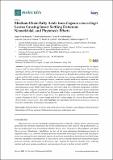Por favor, use este identificador para citar o enlazar a este item:
http://hdl.handle.net/10261/181560COMPARTIR / EXPORTAR:
 SHARE SHARE
 CORE
BASE CORE
BASE
|
|
| Visualizar otros formatos: MARC | Dublin Core | RDF | ORE | MODS | METS | DIDL | DATACITE | |

| Título: | Medium-Chain Fatty Acids from Eugenia winzerlingii Leaves Causing Insect Settling Deterrent, Nematicidal, and Phytotoxic Effects |
Autor: | Cruz-Estrada, Angel; Ruiz-Sánchez, Esaú; Cristóbal-Alejo, Jairo; González-Coloma, Azucena CSIC ORCID; Andrés, María Fé; Gamboa-Angulo, Marcela | Palabras clave: | Bemisia tabaci Decanoic acid Dodecanoic acid Eugenia winzerlingii Lolium perenne Meloidogyne Myzus persicae Solanum lycopersicum Undecanoic acid |
Fecha de publicación: | 3-may-2019 | Editor: | Multidisciplinary Digital Publishing Institute | Citación: | Molecules 24(9): 1724 (2019) | Resumen: | Eugenia winzerlingii (Myrtaceae) is an endemic plant from the Yucatan peninsula. Its organic extracts and fractions from leaves have been tested on two phloem-feeding insects, Bemisia tabaci and Myzus persicae, on two plant parasitic nematodes, Meloidogyne incognita and Meloidogyne javanica, and phytotoxicity on Lolium perenne and Solanum lycopersicum. Results showed that both the hexane extract and the ethyl acetate extract, as well as the fractions, have strong antifeedant and nematicidal effects. Gas chromatography-mass spectrometry analyses of methylated active fractions revealed the presence of a mixture of fatty acids. Authentic standards of detected fatty acids and methyl and ethyl derivatives were tested on target organisms. The most active compounds were decanoic, undecanoic, and dodecanoic acids. Methyl and ethyl ester derivatives had lower effects in comparison with free fatty acids. Dose-response experiments showed that undecanoic acid was the most potent compound with EC50 values of 21 and 6 nmol/cm2 for M. persicae and B. tabaci, respectively, and 192 and 64 nmol for M. incognita and M. javanica, respectively. In a phytotoxicity assay, medium-chain fatty acids caused a decrease of 38–52% in root length and 50–60% in leaf length of L. perenne, but no effects were observed on S. lycopersicum. This study highlights the importance of the genus Eugenia as a source of bioactive metabolites for plant pest management | Versión del editor: | http://dx.doi.org/10.3390/molecules24091724 | URI: | http://hdl.handle.net/10261/181560 | DOI: | 10.3390/molecules24091724 | ISSN: | 1420-3049 |
| Aparece en las colecciones: | (ICA) Artículos |
Ficheros en este ítem:
| Fichero | Descripción | Tamaño | Formato | |
|---|---|---|---|---|
| molecules-24-01724.pdf | 1,75 MB | Adobe PDF |  Visualizar/Abrir |
CORE Recommender
PubMed Central
Citations
2
checked on 25-abr-2024
SCOPUSTM
Citations
16
checked on 23-abr-2024
WEB OF SCIENCETM
Citations
12
checked on 27-feb-2024
Page view(s)
224
checked on 29-abr-2024
Download(s)
185
checked on 29-abr-2024

